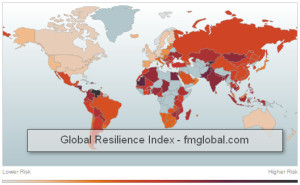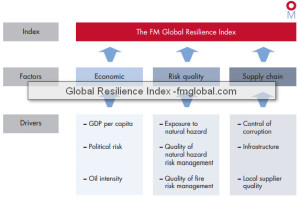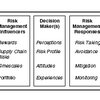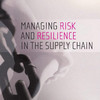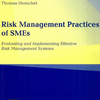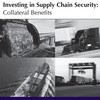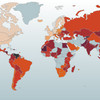 The 2015 FM Global Resilience Index provides an annual ranking of 130 countries and territories according to their business resilience to supply chain disruption. Presented both as a report and an online map it is a visually impressive way of conveying an important message: Beware of where you do your business. As to my home turf the report Norway retains its top position in the index from last year, with strong results for economic productivity, control of corruption, political risk and resilience to an oil shock.
The 2015 FM Global Resilience Index provides an annual ranking of 130 countries and territories according to their business resilience to supply chain disruption. Presented both as a report and an online map it is a visually impressive way of conveying an important message: Beware of where you do your business. As to my home turf the report Norway retains its top position in the index from last year, with strong results for economic productivity, control of corruption, political risk and resilience to an oil shock.
The map
This is how the map looks like for 2015
It’s definitely intriguing to see which countries that rank at lower end and higher end of the resilience scale.
Comprehensive and complete?
Supply chain risk is one of the leading causes of business volatility, so says the report.
The FM Global Resilience Index is the first data-driven tool and repository that ranks the resilience of 130 countries and territories to supply chain disruption. It is designed to help executives evaluate and manage unknown risk potentially inherent in the countries they rely upon. Nine key drivers of supply chain risk are grouped into three categories: economic, risk quality and supply chain factors.
Well, lets take a closer look at how the index is calculated
Levels, factors and drivers
The index is calculated at three levels. Level 1 of the index provides a country ranking of business resilience to supply chain disruption. Level 2 comprises three factors, the core elements of resilience: economy, risk quality and supply chain. Level 3 includes a set of nine drivers that determine the business resilience to supply chain disruption for a country: GDP per capita, political risk, vulnerability to an oil shock, exposure to natural hazard, quality of natural hazard risk management, quality of fire risk management, control of corruption, infrastructure, quality of local suppliers:
I think this index does capture most of what goes into measuring resilience, although it’s hard to judge from the outside what actually goes into the calculations of levels, factors and in particular, the drivers. This is proprietary data. That said, I have no doubt that the scores are statistically sound and based on valid data.
Conclusion
In their own words, FM Global describes the index as
The index offers business executives an additional resource to help in prioritising supply chain risk management and guiding strategy in four key areas:
1. Selecting suppliers based on the supply chain risk/resilience of the countries in which they are located,
2. Deciding where to locate facilities,
3. Evaluating the resilience of the countries hosting existing facilities, and
4. Assessing the resilience of the countries where customers’ facilities are based.In summary, the index provides a robust, composite view of business resilience to supply chain disruption around the world.
A bit of marketing here, but worth looking at, as an initial step in assessing one’s own supply chain resilience.
Related links
- fmglobal.com: Global Resilience Index
Related posts
- husdal.com: 2008 Marsh Consulting Risk Report

